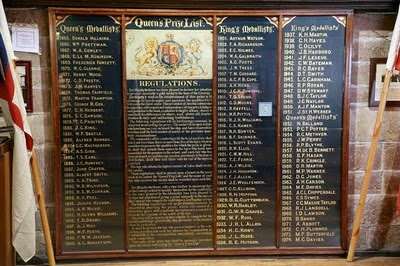Last week I posted a letter written by Samuel Dawson to his aunt Emma Dawson in Melbourne. The letter gives names of many family members but also mentions other significant information. As a family historian I need to examine the letter for information that can fill in more of the story of Samuel and his family.
From his letter the key points included:
- Samuel was a Conway cadet
- Going into Merchant Service with the ship British Envoy
- His sister was studying at Queen's University
- The potato crop failed in Ireland in 1878
- Brother George often leads the deer hunt
- Samuel goes to the races
- He mentions a rifle match at Wimbledon
- Two sisters were staying at a fashionable watering place in Ireland
- Exhibition in Paris
- HMS Euridyce had recently sunk
I didn't know anything about the Conway so last week, I spent some time finding out what I could about HMS Conway and Samuel Dawson.
The HMS Conway 1859 - 1974 website was a gold mine of information.
In 1864 Queen Victoria instigated the Queen's Gold Medal and annual prizes of £50 for the cadets. Samuel Dawson was therefore the 14th winner of this prestigious award.
I was fortunate to find a photo of the Queen's Prize List.
 |
| Queen's Prize List - 1878 - S. C. Dawson |
Samuel's letter mentions that he also won a telescope. He would have won either the Chairman of the Conway Committee Prize or the Royal Geographical Society Prize.
I don't think life on the Conway would have been as easy as life back on the farm.
Cadet records are housed at the Merseyside Maritime Museum, Albert Dock in Liverpool. Guess who walked past its closed doors one evening last April? Little did I know what I was missing out on. The Conway Chapel is now at Birkenhead across the Mersey from where I was staying. Perhaps I'll have to go back!I don't think life on the Conway would have been as easy as life back on the farm.
The 'Teaser' probably derived its name from the rope ‘Starters’ used historically in the RN; short lengths of rope used to strike, encourage or "start" any crewman who did not respond promptly to an order. The Teaser was a vicious little weapon made from 3/8" tarred hemp maybe 18" overall with an eye-splice at one end, and a 6" back splice at the business end. The back splice thickened and strengthened the rope. The back splice was also "whipped" using a very thin twin to give it further strength and make it less flexible. It was stored in a bottle of salt water which gave it the consistency of a metal bar. Sometimes there was metalwork in the whipping. This rope was then used to beat cadets as a punishment. In the early years it was wielded liberally by anybody with the slightest pretence to petty authority. Over time it was used far less and in more controlled circumstances. It was an extremely painful punishment which very few Conway cadets avoided.

Sharon - this is going to be fascinating reading! Great start and I love the theme you have chosen. Looking forward to learning more about your historical research. BTW I love the title!
ReplyDeleteLesleigh